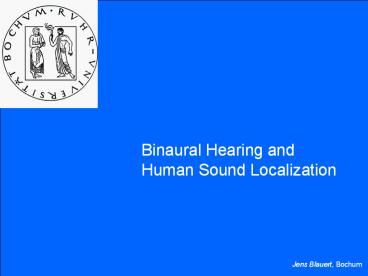Folie 1 - PowerPoint PPT Presentation
1 / 37
Title:
Folie 1
Description:
Title: Folie 1 Author: blauert Last modified by: Jonas Braasch Created Date: 11/18/2005 10:02:53 PM Document presentation format: On-screen Show Company – PowerPoint PPT presentation
Number of Views:52
Avg rating:3.0/5.0
Title: Folie 1
1
Binaural Hearing and Human Sound Localization
Jens Blauert, Bochum
2
a???e?? (akúin)to hearAcoustics
Physics Psychophysics
sounds sensations
Psychophysics sensations
Physics sounds
acoustic event auditory
event
3
Head-Related Coordinate System
4
Some Key Words
5
Effect of Head Movement
6
Binaural Hearing and Human Sound Localization
- Introductory remarks - Directional
hearing in the median sagittal plane -
Directional hearing with sounds from lateral
directions - Distance perception and
inside-the-head locatedness - Summing
localization - Auditory precedence and the
echo threshold - The effect of interaural
decorrelation - Binaural signal detection
- Suppression of reverberance and coloration
- Summary
7
Directional Hearing in the Median Sagittal Plane
Directional hearing in the median sagittal plane
8
directional bands
boosted bands
1/3 oct noise
Directional Hearing in the Median Plane
9
Directional Hearing with Sounds from Lateral
Directions
10
ear axis
Lateralization
11
attenuators delay lines
Generation of ITDs and ILDs
12
Lateralization Blur for ILDs
13
Lateralization Due to ILDs
14
Lateralization Blur for ITDs
15
right ear
left ear
ITD-Lateralization Cues
16
Lateralization due to ITDs (broad-band signals)
17
Distance Perception Inside-the-Head
Locatedness
18
Summing Localization Auditory Precedence
Echoes
19
Standard Stereo-Listening Arrangement
20
Summing Localization for Broad-Band Sounds
21
Ear Signals for Impulsive Sounds in Stereo
22
Summing Localization with Sideways Loudspeakers
after Plenge Theile
23
primary auditory event
broad- band sounds
echo
Auditory Effects with Two Coherent Sound
Sources Summing localization Precedence
Effect Echo Threshold
24
signal running speech of 50 syllables/s
delay of the reflection
Precedence Effect, Haas Effect and Backward
Inhibition
25
The Effect of Interaural Decorrelation
26
Some Further Key Words
27
3 independent noise generators
Controlling the Degree of Coherence
28
Spatial Extent of the Auditory Event as a
Function of Interaural Correlation after
Dubrovski Cherniak, 1966
29
The Perceptive Phenomena of Auditory
Spaciousness
Pioneer researches e.g., Kuhl, West, Marshall,
Barron, Schroeder, Morimoto
30
Binaural Signal Detection Suppression of
Reverberance and Coloration
31
The Binaural IntellegibilityLevel Difference,
BILD Cherrys Experiment
32
degree of AM, m
reverberant chamber
reverb
threshold of perceptibility
anechoic
Binaural Suppression of Reverberance Danilenkos
Experiment
33
Advantages of Binaural Hearing
higher localization accuracy, lower blur better
source segregation (transparency) suppression of
undesired signals (cocktail-party
effect) suppression of coloration and
reverberance (better articulation) gtgt clearer
auditory perspectiveltlt better sense of
envelopment higher auditory source width
(auditory spaciousness) gtgt better spatial
impressionltlt
Higher Quality of the Acoustics!
34
Thank You for Your Attention
jens.blauert_at_rub.de www.ruhr-uni-bochum.de/ika
35
More details regarding the topic of this lecture
can be found in Jens Blauert (1997) Spatial
Hearing The Psychophysics of Human Sound
Localization published by The MIT Press,
Harvard MA, ISBN 0-262-02413-6
36
TASK A Young men and women (about 30 years
old) have applied to be admitted to a school
for airline pilots. For being accepted, they
must have very good spatial-hearing
capabilities. This is necessary, among other
reasons, because they have to respond correctly
to signals from auditory displays in the
cockpit. Outline a battery of perceptual tests
which could be used to evaluate these
capabilities. (a) What would you
measure? (b) Which methods would you
apply? (c) What equipment would you need?
37
TASK B The binaural-hearing capabilities of
elderly people (over 65 years) are to be
evaluated by means of routine screening tests.
The goal is to assess their abilities to
localize sounds in space and to communicate
under acoustically adverse conditions. The
information is needed , among other reasons, to
decide if hearings aids should be applied to
them and, if yes, which kind of these?
Outline a battery of perceptual tests that could
be used to evaluate these capabilities. (a)
What would you measure? (b) Which methods
would you apply? (c) What equipment would you
need?































